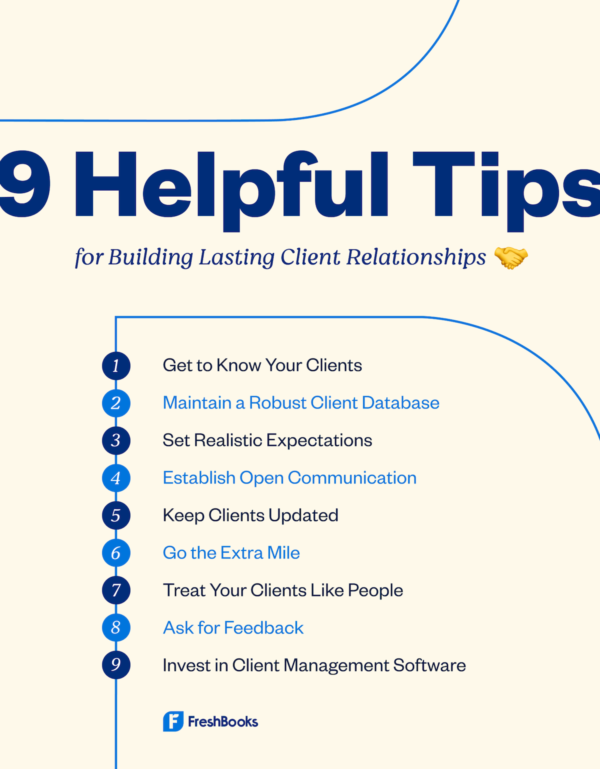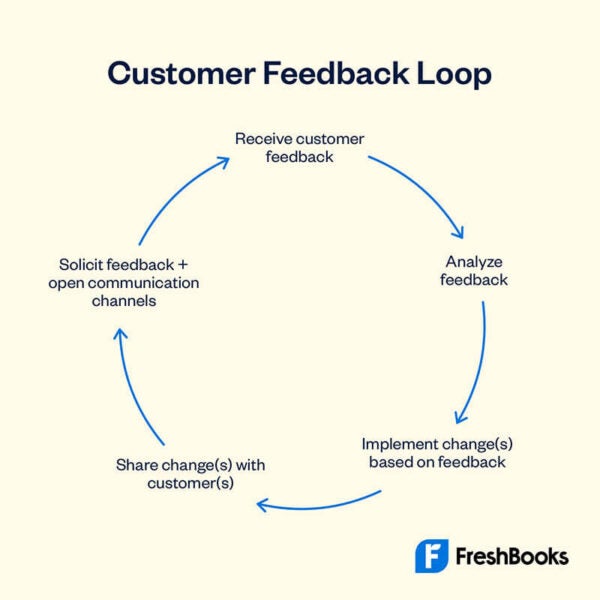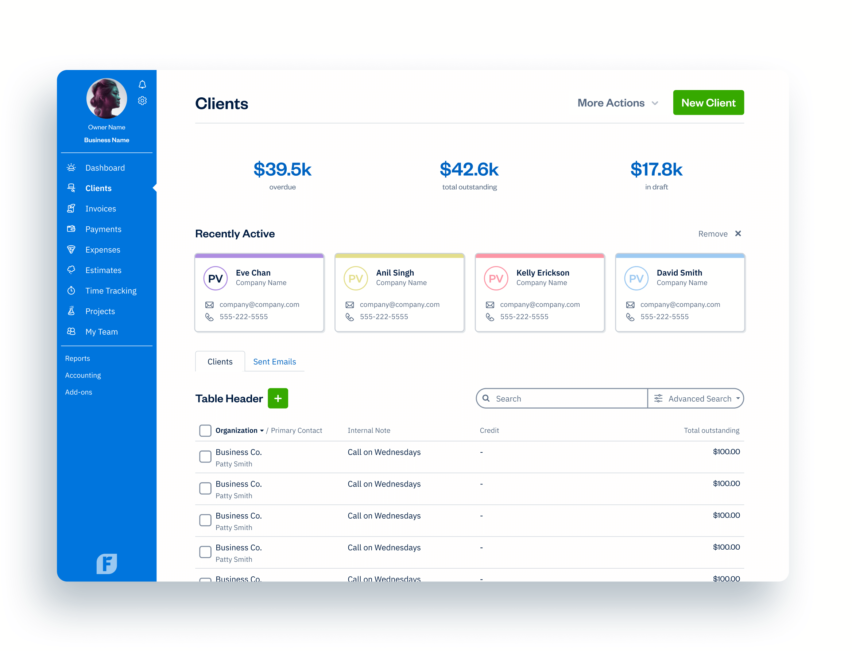Customer loyalty and retention begin with effective client management. Improve the quality of your client relationships with these tips.

As any seasoned service provider will tell you, winning a client’s business is only half the battle. From there, you’ll need to carefully manage your relationship with them if you want to deliver a satisfying client experience and keep working with them in the future.
After all, 61% of customers will switch over to a competitor after just 1 bad customer experience, according to Zendesk.
But once you master the art of client management, you’ll attract and retain more of your ideal clients—and your business will thrive as a result. Jumpstart your journey with the following 9 tips on improving your client management processes.
Table of Contents
What Is Client Management?
Simply put, client management is the process of managing relationships with current and prospective clients.
Compared with customers, who typically buy a product or service 1 time, clients have the potential to engage your services again and again. So client management aims to build more personalized, long-term relationships.
Keep in mind that your goal here isn’t management for the sake of workflows or efficiency. Well-run client management processes are designed with much bigger things in mind: Building healthy client relationships, meeting their needs, and improving your overall client service and client experience.
The Most Common Client Management Pitfalls and How to Avoid Them
The most common mistakes service-based businesses make when managing clients typically fall into 1 or more of the following categories:
Insufficient Insight Into Client Needs
If you don’t make an effort to understand your client’s business or their needs, you won’t be able to help them succeed. Focus on their needs and goals, rather than simply imposing a set of services on them.
By showing that you care about their success and well-being—and not just the revenue they bring to your business—they’ll understand that they can rely on you in the future.
Disorganization
When people do business with you, they trust you to take work off of their plate so they can focus on what they do best. Being disorganized can result in your client needing to manage you on top of the work they send your way, which will leave them feeling exhausted and frustrated.
Remember that client retention and management is always a work in progress. It’s not something you do once and forget about. Improve your client management processes, little by little, to ensure you successfully meet your client’s needs and that nothing falls through the cracks.
Lack of Communication and Transparency
Clients expect honesty and transparency from the companies they do business with.
And according to research, failing to meet expectations or breaking their trust comes with major consequences: A survey from YouGov found that lying about performance was the biggest reason consumers changed products or providers. So if you want to grow your business, improve how you communicate with your clients first.
Good client relationships are built on trust, which businesses must cultivate over time. But even with brand-new clients, you can avoid the mistakes above by establishing an effective client management system for your business.
9 Helpful Tips for Building Lasting Client Relationships
Client management isn’t a skill that comes easily to everyone. But with time and effort, it’s a skill anyone can get better at.
To get you started, here are 9 best practices for implementing a client management system that helps you delight your clients and deliver outstanding service.
1. Get to Know Your Clients
When you understand your clients and their business needs, you become better able to provide exceptional results and support their business.
On the other hand, failure to understand the client’s needs and goals can leave you (and them) feeling discouraged. At worst, you might even lose the client and hurt your reputation—especially if you work in a niche industry.
Learn as much as you can about the client at every opportunity. The information you need will ultimately depend on your business model. However, it’ll be helpful to gather the following basic client details early on in your working relationship:
- Specifics of their industry as it relates to your business
- Why they’re interested in your services
- Other options they have
- When your services are most useful to them
- Their preferred methods of communication
- How they like to pay for services
You won’t always have to ask clients directly to get the information you need. In many cases, you can learn a lot from background research and analytics, surveys, one-on-one conversations, client reviews, and even comments on your website or social media pages.
2. Maintain a Robust Client Database
Every interaction with a client is an opportunity to gather useful information.
The information you gather at the start of your relationship can increase your chances of success with the client. And when you ask for feedback (more on this in tip No. 8), you’ll also want this information readily available to ensure you meet client expectations in the future.
But without a process for documenting and storing client data, you risk losing it all—along with the connections you could build with your client.
You can safeguard against this by keeping each client’s basic information, needs, preferences, and activity in a place that’s accessible to your entire team. This could be a simple Google document when you first start out, or a dedicated client management tool once you have more clients with more complex needs.
This level of organization becomes even more important as your business grows and you delegate more responsibilities to your team.
Having a well-documented and easily accessible client database allows you to tailor your services based on each client’s needs and empowers your team to resolve concerns on their own.
3. Set Realistic Expectations Early On
Set yourself up for smooth working relationships by managing client expectations from Day 1. What should your clients expect from you? And conversely, what expectations might they have for you?
In addition to nailing down project basics such as goals and objectives, deliverables, timelines, and budget, you may find it helpful to share other details that might affect the outcome of the project.
“A common mistake I see is overpromising and not defining your core competency,” says Brooks Rocco, the owner of content marketing and branding studio Brookside Media. “It’s important to set expectations very clearly upfront—not just around client needs, but also of your own abilities.”
Be honest about where your specialties lie and focus your discussions on the skills you do bring to the table. “Position yourself as a leader in a certain area, and your relationships will flourish as your personal brand becomes definable and promotable,” continues Brooks.
By ensuring you and your client are on the same page about what you do and what you can deliver for them, you’re much more likely to have a successful working relationship together.
4. Establish Open Communication
It’ll be challenging to implement any of the tactics described here without channels for open communication with your clients. They should feel comfortable coming to you with questions, and you should be able to respond to their requests in a professional and timely manner.
Cultivating open communication starts at the beginning of the relationship, typically when prospective clients inquire about your business. Ensure they know who to contact and when, and give them multiple ways to get in touch.
From there, your communication practices with clients may include:
- Weekly email check-ins from your client manager
- Conference calls when a milestone is approaching
- In-person team meetings
Rodolphe Dutel, the business owner behind the job-board website Remotive, gives his clients a few more ways to keep in touch with his team:
“We send out a newsletter to our existing clients so that they are kept in the loop with news and updates. We’ve also set up a live chat on our checkout page that’s been much appreciated by our clients.”
By keeping open and proactive communication with your clients, you show them that you care about their needs and concerns.
5. Keep Clients Updated
Sending clients regular updates on their projects reassures them that their project remains a priority for your business. So, let them know how the work is going, even if it’s just a quick update on the project’s status every Friday.
If you can, though, consider including even more project details. Offer results or hard data if you can, or small wins, milestones, or opportunities for improvement if you can’t. This helps boost morale and overall satisfaction with your company.
For example, if you have a home construction company, updating clients when their cabinets and ceiling beams are expected to arrive gets them excited. It’s something for them to look forward to, and it makes them feel like they’re a part of your team.
“I personally ensure that [clients] receive regular attention and care,” says Kristopher Mangaccat, who runs his own media production business. “I proactively share new projects and updates with them, ensuring that we remain top of mind. These practices have had a significant impact on the success of our business.”
The bottom line? If clients are confident in your ability to communicate with them, the more comfortable they’ll feel with you—and the closer you’ll be to a long-lasting client relationship.
6. Go the Extra Mile
As a service provider, you’ll always face competition from other service businesses or software tools in your niche. But when you make a consistent effort to exceed your client’s expectations and create an enjoyable experience for them, they’ll do all they can to maintain their relationship with you.
“The biggest mistake I see other service providers make is failing to put their clients first,” says Liz Melton, a freelance content and partner strategy consultant. “And I don’t just mean checking all the fundamental boxes, like turning deliverables in on time or communicating clearly. I mean going the extra mile. I mean showing them how much you appreciate your business.”
Job-board site Remotive shows clients they care by giving them personalized tips on improving their job listings—for free.
Rodolphe explains: “One of our team members will record their screen and educate a client on how they can further improve the job they have posted with us. It’s a personal approach and a decent time commitment on our end, but we don’t charge anything for it. We simply want to connect further with our clients and see them win.”
Going above and beyond client expectations can make all the difference between a client who stays with your business for years and one who leaves for a competitor. Do it well and do it consistently, and you’ll find you’ll always have clients who are willing and excited to work with you.
Small acts of kindness may not make or break your business, but those on the receiving end will certainly remember you for it.
7. Treat Your Clients Like People
At the end of the day, your clients are human beings who appreciate kindness and respect. Build personal relationships with the people behind the business, and watch how your actions inspire loyalty.
For Liz, the multiple ways she incorporates joy into her client experiences prove she’s invested in their well-being and success.
One way she does this is by writing LinkedIn recommendations for them. “I can’t tell you how many times someone has told me this made their day. Writing highly personalized testimonials shows them you care about their career and want others to know how competent they are.”
She doesn’t stop there, either. “I send clients a small thank-you gift each year,” continues Liz. “And I try really hard to make them uniquely personal. For example, if I know a client loves art, I might send them a MoMA gift card. For newer clients that I don’t know as well, a DoorDash or Uber Eats gift card also goes a long way.”
You don’t have to spend anything to make an impact. Kindness is free, and it shows clients you care. Small acts of kindness may not make or break your business, but those on the receiving end will certainly remember you for it.
8. Ask for Feedback
Let’s be real: You can’t meet 100% of your client’s expectations 100% of the time. Sometimes you’ll mess up. But one of the things that separates an average service provider from a stellar one is how they ask for and implement client feedback.
As we touched on earlier, to manage clients effectively you need to understand how you can ensure their success. That requires quality feedback and an effective customer feedback loop.
Your feedback loop should include processes for:
- Asking for feedback via surveys or other outreach methods
- Receiving feedback through always-on lines of communication
- Analyzing feedback
- Implementing changes based on feedback
Here’s what a simple customer feedback loop might look like in your business:
Ideally, you want to ask your clients for feedback on a regular basis, and then really take the time to consider how to implement it into your workflow. By actively listening to their input and acting on it, you show your clients that you take them seriously and prove your commitment to their success.
9. Invest in Client Management Software
Collecting, organizing, and maintaining customer data can be a full-time job. In fact, many large organizations have client managers or a client management team on staff.
For smaller companies and independent contractors, customer relationship management (CRM) software serves a similar purpose at a more affordable price. CRM software (or client management software) serves as a centralized database to store client information and track their activity.
When used effectively, it can shave dozens of hours off of your client management efforts.
“Having robust management software is crucial for efficiently managing client relationships,” says Kristopher. “If I could give advice to my past self, it would be to prioritize organization from the beginning. I would invest more time and resources in adopting a strong system to streamline operations and enhance client satisfaction.”
Using a tool that integrates into other admin processes, like FreshBooks’ client management dashboard, is a simple way to keep client information, invoices, and payments organized in 1 place. Store client details, collaborate on projects, share files, and manage client financial information all from your accounting software.
As your business grows, take advantage of more complex, standalone CRM tools to incorporate marketing automation, project management, and more into your workflows.
Start Improving Your Client Management Skills Today
Good relationships with clients are built on trust. While you can’t earn that overnight, you can lay the groundwork for an exceptional client experience with the best practices other service providers have learned firsthand.
By building a well-oiled client management system using the 9 strategies above, you’ll have an easier time gaining (and keeping) your clients’ trust while also avoiding the obstacles that trip up many new business owners.
This post was updated in July 2023.

Written by Megan Smith, Freelance Contributor
Posted on December 10, 2021


 Is It Time for a Price Increase? Here’s How to Tell Your Clients
Is It Time for a Price Increase? Here’s How to Tell Your Clients Everything You Need to Know About Managing Bad Clients
Everything You Need to Know About Managing Bad Clients 6 Ways to Surprise and Delight Your Customers
6 Ways to Surprise and Delight Your Customers






![Standing Out From the Crowd [Free eBook]](https://www.freshbooks.com/blog/wp-content/uploads/2022/05/Standing-Out-From-the-Crowd_eBook-Blog-Hero-Image-226x150.png)

